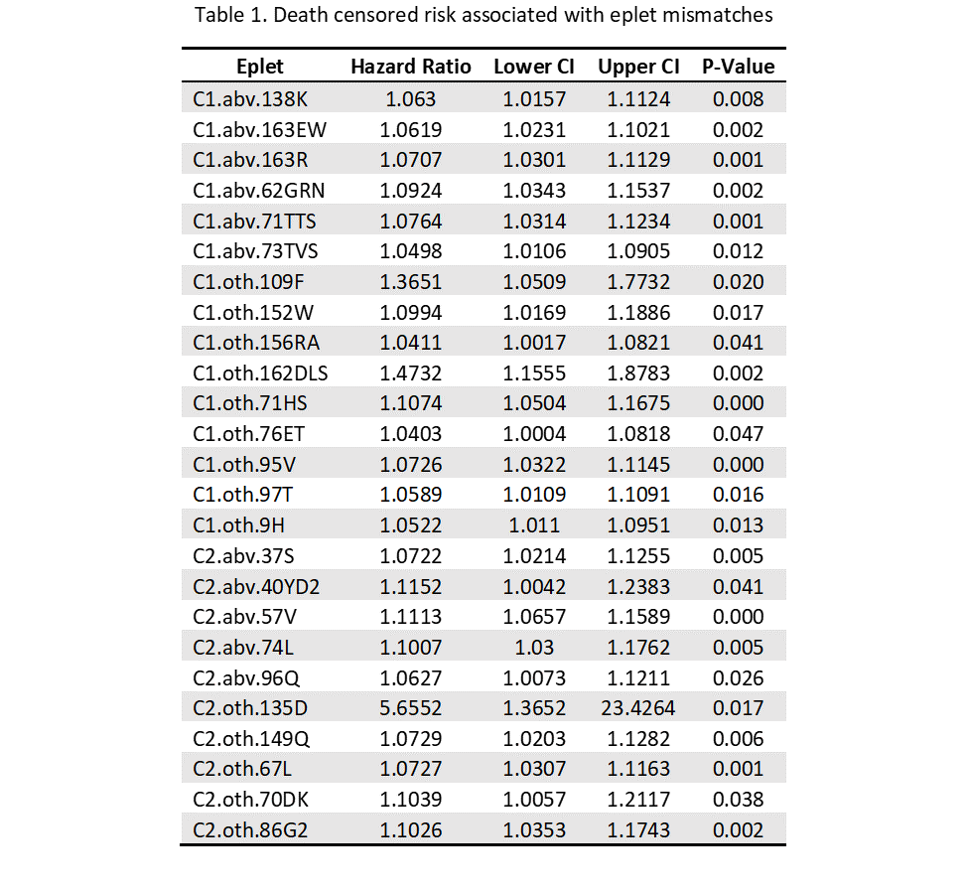Ranking Eplet Mismatches as Predictors of Graft Failure
1McGill University, Montreal, QC, Canada, 2UQAM, Montreal, QC, Canada, 3Emory University Hospital, Atlanta, GA, 4Canadian Blood Services, Ottawa, ON, Canada
Meeting: 2020 American Transplant Congress
Abstract number: 449
Keywords: Epitopes, Graft failure, Immunogenicity, Kidney transplantation
Session Information
Session Name: Kidney Complications: Immune Mediated Late Graft Failure
Session Type: Oral Abstract Session
Date: Saturday, May 30, 2020
Session Time: 3:15pm-4:45pm
 Presentation Time: 3:15pm-3:27pm
Presentation Time: 3:15pm-3:27pm
Location: Virtual
*Purpose: Donor:recipient matching at the level of sequence defined HLA targets (eplets) is being promoted as a biologically sound strategy to prevent graft failure. Because eplet mismatches may differ in immunogenicity, this study sought to distinguish how specific eplet mismatches relate to death-censored graft failure. This area has been under-studied due to the high dimensionality and complex relatedness of HLA genes.
*Methods: We studied a cohort of 118 382 unsensitized US first kidney transplant recipients (2000 to 2015) from the Scientific Registry of Transplant Recipients (SRTR). Allele-level donor:recipient HLA-A, -B, -C, -DRB1 and -DQB1 genotypes were imputed by an algorithm from the National Marrow Donor Program. HLA genotypes were converted to epitypes with 449 potential eplets considered. We applied Lasso penalized Cox regression to 70% of the cohort to select eplet mismatches significantly associated with death-censored graft failure. To verify that eplet mismatches identified by the Lasso penalized Cox regression analysis are predictive of transplant outcomes, we fit, in the remaining cohort (30%), Cox proportional hazard models and estimated hazard ratios (HR) of death-censored graft failure. Models were adjusted for clinically relevant recipient, donor and transplant characteristics. P-value < 0.05 was deemed statistically significant.
*Results: The penalized Cox regression model analysis identified 52 unique eplet mismatches that were common to all training subsets of the cohort. Of those, 25 were statistically significantly associated with death-censored graft failure in Cox proportional hazard models. These particular eplets can be mapped to both class I (C1) and class II (C2) HLA loci and include antibody-verified (abv) and non-antibody-verified (oth) mismatches (Table 1).
*Conclusions: Evidence to date linked cumulative eplet mismatch loads with transplant outcomes. Our analysis of the SRTR was able to distinguish specific eplet mismatches associated with an increased risk of graft failure. Validation in other datasets, will support prioritizing donor:recipient matching on these eplets to achieve superior kidney transplant outcomes.
To cite this abstract in AMA style:
Zhang W, Mohammadhassanzadeh H, Oualkacha K, Gebel H, Klement W, Sapir-Pichhadze R. Ranking Eplet Mismatches as Predictors of Graft Failure [abstract]. Am J Transplant. 2020; 20 (suppl 3). https://atcmeetingabstracts.com/abstract/ranking-eplet-mismatches-as-predictors-of-graft-failure/. Accessed December 16, 2025.« Back to 2020 American Transplant Congress

